#Stone sculptures from Africa
Text

Roman statue of Venus
During the 2nd century AD the most coveted stone for Roman emperors was bigio morato, a dark grey almost black marble sourced from Africa; the most notable example of this marble used in sculpture is the Furietti centaur statues discovered at Hadrian’s imperial palace at Tivoli.
from here
48 notes
·
View notes
Text

•Powwow of the Nonhuman Presenter and Vendor Applications are Open!•
•Greetings! The powwow of the nonhuman event is now accepting applications for presenters and vendors who wish to participate in the first annual powwow of the nonhuman!
What is Powwow of the Nonhuman?
•The powwow of the nonhuman is an annual virtual event meant to promote representation for indigenous peoples and people of color who identify as nonhuman. We are sadly fragmented and unrepresented among the otherkind community, this event seeks to change that sad fact. Powwows are not only for indigenous peoples from the continental americas, though also for indigenous peoples from everywhere in the world! We welcome indigenous peoples from Africa, Asia, Island Nations, Australia, The Middle East, and other parts of the world! All people of color are welcome to this event, regardless of whether or not they identify with being indigenous or not!
Powwow Presenter Details
•Presenters for the powwow of the nonhuman will be allowed to speak about any topic pertaining to their indigenous heritage, their otherkinity, their experiences with spirituality, or their environmental work. The experiences discussed in these presentations can be positive or negative in nature, we want every powwow presenter to feel truly free to express every aspect of themselves. All presentations for the powwow will be pre-recorded and edited in to premier on December 20th. Presenters will be working with staff members and video editors to create their ideal presentation for the powwow.
Powwow Vendor Details
•Vendors for the powwow of the nonhuman will be able to advertise and sell their wares during the event. Vendors for the powwow will be allowed to sell artwork (drawings, paintings, sculptures, ceramics, literature, or music), crafts (pottery, jewelry, dreamcatchers, rattles, medicine bags, drums, pipes, beadwork, baskets, woodworks, and animal medicine), items from nature (flowers, plants, sage, ceremonial wood, stones, crystals, animal pelts, or bones), foods (fruits, seeds, vegetables, baked goods, or candy) and miscellaneous services in between powwow presentations. Vendors for the powwow will be working with staff members and video editors to create a short advertisement for their wares to premier at the powwow December 20th.
Want to Participate?
•If you desire to be a presenter or a vendor for the powwow of the nonhuman, please feel free to send my being a message! If you have any general questions about the powwow, do not be afraid to ask!
•We have a server for event planning! This server is also a general place for people of color who identify as otherkind to meet in a safe environment!
•https://discord.gg/nHtFHwAe4q

#powwow of the nonhuman#otherkind#otherkin#indigenous otherkin#poc otherkin#otherkinity#therian#therianthropy#theriodraconic#theriomythic#alterhuman
27 notes
·
View notes
Text
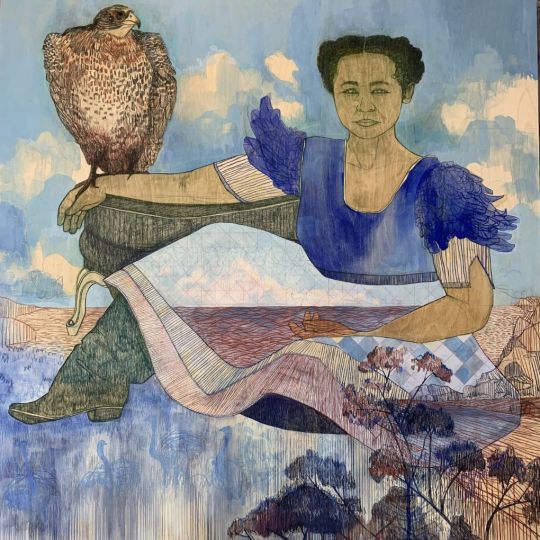



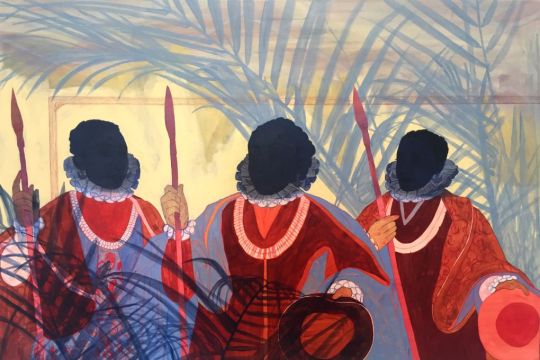


Pamela Phatsimo Sunstrum
Born 1980, Mochudi, Botswana.
The Botswanan-Canadian artist is rapidly building an international reputation for her evocative Afrocentric paintings of mythic characters in landscapes.
She was born in Botswana, but the family also lived in Sudan, Sri Lanka, Malawi and South Africa, and moved back to Ottawa during Sunstrum’s middle school years. She was back in Botswana for high school and then attended university in the United States, assuming she was premed during her studies at the University of North Carolina at Chapel Hill.
Still, “I had always been a step child of the art department,” she recalls. She abandoned any idea of becoming a doctor after a successful artist’s residency in Panama, where she spent two months in the jungle building an earthwork sculpture as a monument to a Nigerian woman sentenced to be stoned for adultery.
“Then and now, I was reading a lot of poetry and fiction and was moved by narratives that involved these condemned female characters, tragic characters,” she said. In earlier work she invented a fictional alter ego named Asme who travelled with a Canada goose; today her characters and her figures are more varied and ambiguous, although mainly female even if the photographs from which she sometimes works may originally show men. For example, one work-in-progress sitting in the small light-filled studio at the back of her Ottawa house, shows a female soldier, partly modern warrior in a combat helmet, partly a lady in a skirt: The source image was of a man in a Scottish regiment wearing a kilt.
https://www.theglobeandmail.com/.../article-ottawa.../
17 notes
·
View notes
Text
This Christmas Party Was So Fun That Now I’m a Communist, by Brennan Lee Mulligan
Highlights:
[I] thought to myself, “This is the most fun I’ve ever seen anyone have. ... This is… so great. This is… completely fucked.”
This party cannot be allowed to happen again. It was too much fun! No human being can justify having that much fun. There is an indirect but tangible connection between my family’s inability to purchase health insurance, and the quality of the hors d’oeuvres at this party. The world that makes my childhood friends go on large, unnecessary detours to get a shot at their dreams is the same world that heaps largely unappreciated splendors on these party-goers. It’s not an intuitive conclusion to draw, but when you think about it, the reason this chocolate truffle tastes so good is that my brother and I went to a state school. The reason this champagne is on the house is that the house is largely on Africa, South America and rural India.
This party is so much goddamned fun and it has to be stopped.
I wondered if I had been too harsh. Perhaps there was some kind of justice to all of this that I, as the malnourished, hayseed-child of the working poor, could not fully comprehend.
In that moment, I knew that I would never again experience a party this fun. Because the next time I was at a party this fun, I’d be burning it to the ground, holding high the banner of the revolution.
---
If you had guessed there would be a fortuneteller at this party, you would have been dead wrong. Because there were two fortunetellers at this party.
This party was so insane, extravagant and incredible that the hosts hired not one, but two separate soothsayers. The services of two women capable of piercing space and time with their minds were required for this shindig. Next to one of the three fully-stocked open bars, there was a woman wearing a bird on her head who was reading palms. And downstairs, in a hallway filled with ancient Buddhist art recovered during the Chinese invasion of Tibet, there was a Romani woman giving Tarot card readings. I mean, take your pick, really. Do you prefer the occult prognostications of cartomancy, or the intimate and personal revelations of the mysteries of your own goddamned hand? Because this party had both.
This party was so far off the fucking chain that you could have one of two magic women tell you what was going to happen to you in your future. And if you didn’t like what she said, you could get a second opinion, and never be more than thirty feet away from a fondue pot.
There was also a magician in a tuxedo walking around doing sleight of hand tricks. So to reiterate: Three different wizards were working at this party.
This party was the most fun anyone has ever had. And something needs to be done about it.
I arrived at the party as they were still setting up. The penthouse, located a few blocks from the eastern edge of Central Park, was in a word "palatial." It felt like I had stepped out of the gilded, art deco elevator into the distant palace of some Caliph at the height of the Ottoman Empire, were it not, I should add, for the many Christmas decorations being put up by an army of party planners. Pine garlands the length of city buses, with the circumference of an elephant’s leg, wrapped around marble banisters on staircases that ascended to impossible balconies overlooking Park Avenue. Shelves lined with ancient and powerful scotches, first edition books beyond reading, paintings and sculptures by artists so French that, were I to whisper their names, I would first need to buy a Rosetta Stone app. And all of this was being slathered in artisanal glass ornaments, gilded candles, sprigs of holly and every other thing that turns the darkest part of the year into the hap-happiest season of all. Guys, this party made the trailer for The Great Gatsby look like the strip mall parking lot where two divorced parents meet to exchange their children.
In the scraps and shreds of memory that come to me from that wild night of celebration, I remember certain landmarks. As guests exited an elevator that opened directly into the foyer of the apartment, they were greeted by butlers holding glasses of bellinis, champagne and sparkling water. They walked to a floor of waitered tables and a small dance floor, while being serenaded by a rotating cast of singers and pianists. These areas were overlooked by balconies with performers and entertainers of various stripes and shades, and from these balconies led hallways that arrived at various catered dining rooms and seating areas, all cozy, lovely and intimate, all just the right size to see that, yes, other people were having fun, but not too many other people were having too much fun too close by. And throughout it all, guests were bombarded with trays of lobster, caviar and truffle oil brioche canapés.
This party was like if the Dalai Lama and Elrond Half-Elven owned a castle together, and had decided to throw a birthday party for Santa Claus. More money than I have yet made in my life was spent on this party. It was immediately the most fun I’ve ever had, and within minutes, I was deeply unsettled.
As the immaculately dressed and bejeweled guests wended their way to banquet tables of delicious food and various dance floors, they were lit from not a single actual light bulb. I don’t know when I realized it, but aside from candlelight and the glow of the city through the windows, there was not a single visible source of light in the entire party. “Why do the rich find light bulbs so distasteful?” I thought. Every light had been tucked, hidden or sequestered from view, ensconced in little cubbies or stowed underneath cabinets, so that a warm glow filled everything, and you couldn’t tell how or from where. It became almost maddening as soon as I recognized it. Where is all this light coming from? Is this why I’m poor? Too much direct light?
While I was trying to piece this together, the music had once again changed, and I peered from the balcony where I was standing, to see the hired singer and pianist walk from the small raised stage with its rented Steinway through the doors into a literal servants’ quarters, like in Downton-motherfucking-Abbey. AND THERE WAS A PARTY IN THERE! A separate party for people working at the first party! The performers, jugglers, soothsayers and probably sex-workers that had been hired by the hosts had a separate catering group attending solely to their needs. This party was so dope, it was spawning sub-parties to bolster the spirits of workers for what I’m now calling “The Motherparty.”
I ducked into the servants’ party to discover that one of the singers had a day-job at the New York Metropolitan Opera. This Christmas party was so fucking great, that one of the 16 people they hired to sing in one of the rooms is a professional Opera singer at the Met.
I began to notice how many people were working at this party. There were the many performers and entertainers, and a fleet of photographers, separate from the gentlemen running the rented photo booth, which swarmed all night with beautiful young women immortalizing their splendor. One such woman was photographed while instagramming herself in front of the photo booth, which is maybe how wormholes are created. There were business staff, house staff, building staff, the host’s personal and executive assistants, custodians, and caterers, all of whom disappeared into grey hallways, designed to be ugly but also kind of invisible, a place where the help disappeared to. When you’re rich, you can afford to have sections of your home into which you never go.
As I watched the quick, nervous movements of the help, I began to look at who was actually attending the party. I ate my free lobster and furrowed my brow. These people probably didn’t even call their free lobster “free lobster.” They probably just called it “lobster.”
I watched the beautiful children of the rich mingle and converse. Young, gay men so fabulous that I couldn’t even tell you the most basic elemental details of what they were wearing. Possibly a fabric? Maybe not. It could have been a ceramic. I just don’t have the facts. Some young Ivy League dudes, pupating senators and ambassadors. The young women were gorgeously dressed, adorned with jewels, and so beautiful that they seemed photo-shopped in person. It would be easy to write off these airbrushed debutants as vapid, but they weren’t. They all had sharp, predatory eyes and laughed quickly and with fierce intelligence. They were ubermensches, as much the daughters of their bloodthirsty, corporate fathers as their supermodel mothers. These stunning women would spend the rest of their ball-gowned lives handing out their fathers’ likely ill-gotten fortunes to worthy charities, and going to parties just like this one.
From a distance, it was hard to tell the mothers and the daughters apart. Rich women don’t age, they just desiccate. Their jewelry, hair, gowns, even their posture and attitude all stay the same as their elegant, somewhat more humid daughters. A rich young woman and a rich old woman, standing next to each other, kind of look like a snake having perfectly shed its skin.
The old men were by far the most diverse bunch. Old billionaires wear whatever the fuck they want. One man wore a maroon, velvet, three-piece suit and a paisley cravat, and he must have been sweating in it, but I couldn’t tell because he had doused himself in a cologne that I’m going to call “A Million, Billion Different Kinds Of Fruit, by Calvin Klein.” There were two shaven-headed men of Caucasian descent, wearing black hakama robes and some kind of pendants. They had white socks and sandals, and from the way people were bowing to them, I’m guessing they were some kind of religious officials, but I can’t be quite sure. Whatever faith they practiced, it wasn’t Christianity, Judaism, Islam, Buddhism, Hinduism, Sikhism, Baha’i, Taoism, Shinto, Confucianism, Voodoo, Wicca or the Dreamtime Faith of the Aboriginal Shamans. If I had to guess, I would say they were either members of the Illuminati, or we are living in the Matrix and they are priests from the remaining human city in the real, outer world.
I don’t know what religion they were from. Do we get why that’s scary? Aside from the fact that a vast chunk of my education centered on world religions and mythology, religions really want you to know about them. That’s their whole business model. They tell you why things are the way they are and then you give them money. So the fact that there’s a religion that I’m too poor to know about is deeply troubling.
These rich old billionaires were the kindest, sweetest old gents. In conversations I overheard more than once, a man worth more than my entire extended family (which is Irish and therefore vast and mighty) talked about another man at the party as “just being the sweetest soul,” or referred to a cupcake at a certain café as “sinfully seductive.” And I realized, these men may have been cutthroat sharks before, or they may have inherited their fortunes, but none of that matters now. They won. They won life. They are lions that, having killed enough gladiators, are now left gloriously alive to become old and toothless. The host of the party had an entire wall covered in plaques and trophies. I read most of them, and still couldn’t tell you what he did for a living. Because whatever he had done, he certainly didn’t need to do it anymore. His accomplishments referenced his humanitarianism, his civic heroism and his contributions to culture and civilization. So whether or not this man had worked at Bain Capital gutting companies in the American Heartland didn’t matter, because he had rescued a bunch of Tibetan art and now he was kissing other billionaires on both cheeks and saying, “Tom, I’m in love with you!” because who gives a fuck, I’m rich!
I watched these crazy old holiday wizards and their jeweled scarab wives, their Oxford sons and Cambridge daughters, and thought to myself, “This is the most fun I’ve ever seen anyone have. Louis the XVI would've shit a brick if he'd ever thrown a party this good. This is… so great. This is… completely fucked.”
I began to notice that people were looking at me funny. For a moment I became scared that they realized I was poor. Perhaps I had used the wrong fork, or a moth had flown in lazy spirals out of my wallet, or my toes had popped out of the holes in my shoes. But then I realized it was my expression that was drawing looks. I looked flabbergasted and astounded. And they didn’t.
That’s when I realized it. These motherfuckers weren’t going to the best party of their lives. They weren’t even necessarily going to the best party of their week. Who knows? Maybe one of these plutocrats was sneering at the lack of a third fortuneteller. “No augur divining mysteries from the movement of birds? No oracle breathing poison and screaming prophesies? You call this a Christmas Party!”
Well fuck that!
This party cannot be allowed to happen again. It was too much fun! No human being can justify having that much fun. There is an indirect but tangible connection between my family’s inability to purchase health insurance, and the quality of the hors d’oeuvres at this party. The world that makes my childhood friends go on large, unnecessary detours to get a shot at their dreams is the same world that heaps largely unappreciated splendors on these party-goers. It’s not an intuitive conclusion to draw, but when you think about it, the reason this chocolate truffle tastes so good is that my brother and I went to a state school. The reason this champagne is on the house is that the house is largely on Africa, South America and rural India.
This party is so much goddamned fun and it has to be stopped.
The last singer finished a tear-jerking rendition of Ave Maria, and the DJ came out. A man who looked like a young, handsome Santa Claus wheeled out his holly-studded turntable and then killed it. Every song he played was fucking perfect. Cecilia. Signed, Sealed, Delivered. Rescue Me. This goddamned DJ could do no wrong. And the patricians began to dance.
And oh how they danced. I used to think that only we poor, starving bohemians could truly dance with the hedonism and reckless abandon of our pagan ancestors. I was WRONG, guys. Starving artists don’t dance with reckless abandon. We dance like we’re trying to forget that the rent is past due. We dance to sweat off that last box of Annie’s Mac & Cheese. We dance to trick the endorphins into healing our tired, unkempt bodies.
The rich, however, dance as if possessed by Pan himself. The young and old alike gyrated, wiggled and bounced like they had not a care in the world. Sorry, let me rephrase that. The young and old alike gyrated, wiggled and bounced BECAUSE they had not a care in the world. And it was magical. Every face beamed with glorious jubilation. I saw five separate people fall in love that night, and I know it’s going to work out, because of just how good that party was. It was the most magical night I have ever witnessed, and so help me God, I will toil unyieldingly to ensure it never happens again.
For a brief moment I surveyed the upper balcony. The host and his wife smiled gaily, singing along and dancing. They looked so serene. So happy. And I saw the host turn, and start handing out tip money to the staff. $50 bills flew from his fingers into the waiting hands of the army of party workers. And they thanked him for his kindness. And he was kind. He was a kind man, this white-suited oligarch. In that moment, I wondered if I had been too harsh. Perhaps there was some kind of justice to all of this that I, as the malnourished, hayseed-child of the working poor, could not fully comprehend.
The caterers left the hall, and the DJ stopped.
That’s when I noticed that while the dance party had been happening, a Pinkberry and a Wafels & Dinges had both opened inside the penthouse.
Let me say that again.
A Pinkberry and a Wafels & Dinges both had their grand openings during and inside this party. Two, miniature, satellite restaurants with mobile service stations, serving free food, staffed by uniformed employees, with their full assortment of products, had sprouted up within the span of ten minutes. For every fortuneteller in this party, there was a restaurant in this party. And the choir sang. And the people ate. And the champagne flowed. And the two fortunetellers ordered extra nutella on their wafels & dinges. And the velvet suit fruit man hugged a young gay boy wearing a scarf with the whole Bhagavad Gita written on it and whispered, “We are never, ever going to die.”
In that moment, I knew that I would never again experience a party this fun. Because the next time I was at a party this fun, I’d be burning it to the ground, holding high the banner of the revolution.
Merry Christmas. Happy New Year. Fight the Power.
— Brennan Lee Mulligan
#thought-provoking when I first read it a while back#thinking about it again recently#wealth inequality
7 notes
·
View notes
Photo
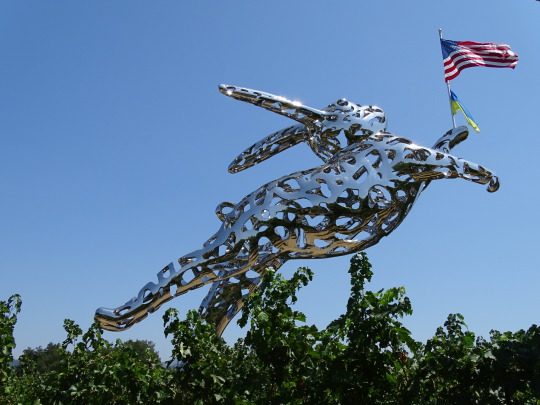
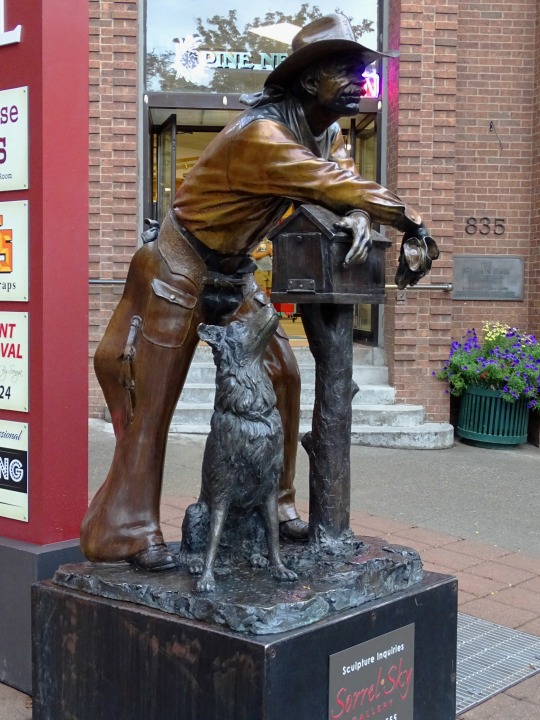







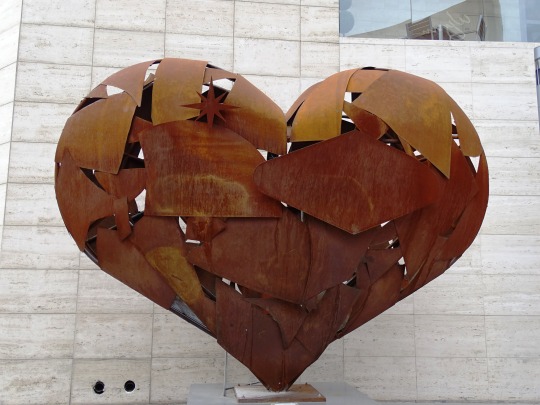
International Sculpture Day
International Sculpture Day is observed on the last Saturday of April every year and this year, it falls on April 29. It is an internationally recognized holiday that commemorates the art of sculpture and sculpted works. Sculptures are a type of visual art that is three-dimensional. Stone sculptures have been proven to last significantly longer than other works of art made of perishable materials, and they account for the vast bulk of all surviving non-pottery art from ancient cultures to this day. Sculptures have always been a major component of religious devotion in many cultures, and enormous sculptures were commonly used to represent religion or politics until recently. The ancient Mediterranean, India, and China, as well as various cultures in Central and South America and Africa, have the most surviving sculptures.
History of International Sculpture Day
The first undisputed sculpture pieces came from the Aurignacian culture in Europe and southwest Asia, which was active at the start of the Upper Paleolithic period. This culture developed well-crafted stone tools, pendants, ivory beads, and other forms of art. They are also attributed to being the first to create cave art and three-dimensional figures.
The Löwenmensch, found in Germany’s Hohenstein-Stadel area, is an anthropomorphic figure carved from mammoth ivory. It is believed to be one of the oldest known uncontested examples of figurative art, standing at 0.9 inches tall. Most prehistoric art that has survived to this day is movable sculptures found throughout central Europe.
The Swimming Reindeer from around 13,000 years ago is one of the greatest Upper Paleolithic Magdalenian bone carvings, however, it is outnumbered by engraved pieces, which are sometimes considered sculptures. The Tuc d’Audoubert caves in France, where a talented sculptor used a spatula-like stone tool and his fingers to build a pair of large bison against a limestone rock tens of thousands of years ago, are home to two of the world’s largest prehistoric sculptures.
Much of the figurative sculpture in Europe at the beginning of the Mesolithic era has been greatly reduced. These sculptures have remained less of a common element in art other than relief decoration of practical objects until the Roman period, despite works such as the Gundestrup cauldron from the European Iron Age and the Bronze Age Trundholm sun chariot.
The Mesopotamian conquest, as well as much of its surrounding territory by the Assyrians, created a larger and wealthier state than was previously usual in the region, with particularly grandiose art in palaces and public places, clearly an attempt to match the glory of the Egyptian empire art. The Assyrians created their sculptures in great numbers using easily carved stones from Northern Iraq.
International Sculpture Day timeline
800—721 B.C The Assyrian Lamassu is Created
The Assyrian gate guardian sculpture, Lamassu, is created.
1513—1515 Michelangelo’s Moses Sculpture is Created
Michelangelo creates the sculpture of Moses sometime during these years.
1793 Crucifixion of Jesus Christ Sculpture is Created
The Spanish sculpture of the Crucifixion of Jesus Christ is made from wood and polychrome.
1998 Angel of the North Sculpture is Created
Sculptor Antony Gormley creates the sculpture of the Angel of the North.
International Sculpture Day FAQs
Which country is famous for sculpture?
The Western sculpture tradition originated in ancient Greece, and the country is well-known for producing great masterpieces during the classical period. During the Middle Ages, Gothic sculpture expressed the Christian faith’s agonies and emotions.
Does the date for International Sculpture Day change?
Yes. The date for International Sculpture Day is the last Saturday of April every year.
Where did sculptures originate?
The earliest sculpture samples belonged to the Aurignacian culture, which was in Europe and southwest Asia and was active at the beginning of the Upper Paleolithic period.
International Sculpture Day Activities
Visit a museum of sculptures
Make your own sculpture
Share on social media
International Sculpture Day is an excellent reason to visit any of the many sculpture museums and historical sites that feature beautiful sculptures. This is also a chance to learn more about the history of sculptures and their sculptors.
You can seize this opportunity and spark your creativity by building your very own sculpture using available and sustainable materials. You can create something meaningful that you can put on display in your home.
Use the hashtag #InternationalSculptureDay to share all of your activities for International Sculpture Day on social media! Take as many pictures as you can and tag your friends!
5 Interesting Facts About Sculptures
Sculpture is three-dimensional
There are various materials for sculpting
Sculptures have cultural and religious origins
There are two major types of sculptures
Stone sculptures are the most durable
A sculpture is a three-dimensional visual art, which makes it all the more “realistic.”
Unlike in the past, when sculpting materials were only limited to stone, bronze, and a few others, modernism has changed the order of things and a variety of materials can be used for sculptures.
Most prehistoric sculptures were born out of a reference to cultural, religious, and political themes.
There are two major types of sculptures which are “statues” and “relief” sculptures.
Most of the prehistoric sculptures and other art forms are stone sculptures.
Why We Love International Sculpture Day
Sculptures tell us stories
Art relaxes the mind
It is food for the soul
Most sculpture works have a story to them; either of religious, cultural, or political origin. International Sculpture Day allows us to learn about the history of sculptures and the artists who created them.
Creating art relaxes the mind. It allows people to showcase their passion by doing something they love.
Ever seen a sculpture or other work of art and felt so… filled? Exactly. Viewing beautiful art pieces is like food for the soul.
Source
#Waiting on an Answer by George Lundeen#Bad Decision by Vic Payne#USA#Bunny Foo Foo by Lawrence Argent#Big Bill Murphy by Adam Skiles#Bliss Dance by Marco Cochrane#Satos Horse by Jim Johnson#Heartfullness Vegas by Katy Boynton#Trouvaille by Kasia Polkowska#Beliers by François-Xavier Lalanne#International Sculpture Day#29 April 2023#last Saturday in April#summer 2022#original photography#public art#travel#vacation
3 notes
·
View notes
Text
Creative Project
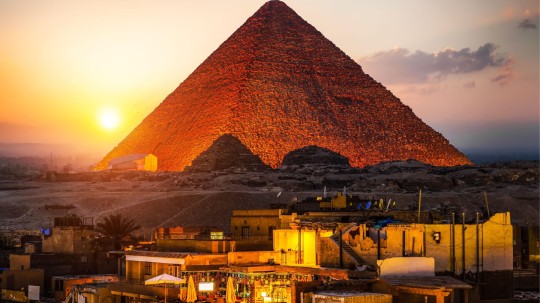
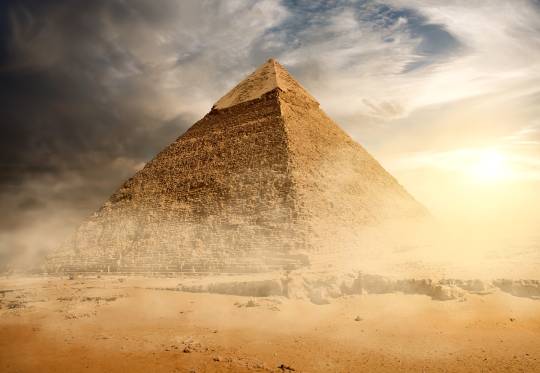

The first site I saw on my voyage to ancient Egypt was the Great Pyramid of Giza, the largest of the Pyramids of Giza. The Pyramids of Giza were royal tombs built for the three pharaohs, Khufu, Khafre, and Menkaure. The Pyramid of Giza is the biggest Pyramid of Giza. The Great Pyramid of Giza's creation took about 20 years. Pharaoh Khufu was the pharaoh who created the Great Pyramid of Giza. The Great Pyramid of Giza is one of the "seven wonders of the world" and is the only one still standing today. Many people consider it to be the biggest building ever constructed. The original pyramid was 482 feet high and had four equal sides measuring 755 feet. There were about 2 million stones used to build the Great Pyramid of Giza. The stones used to construct the pyramid had polishing made with limestones. According to researchers, "Some of these stones are of such immense size and weight (such as the granite slabs in the King's Chamber) that the logistics of raising and positioning them so precisely seems an impossibility by modern standards." (worldhistory.com) The chief purpose of building the pyramids was to house the dead body of a pharaoh. The Egyptians believed that after a person dies, people would continue living in a similar world to the one on earth in the afterlife. During the burial ceremonies, people would leave all types of riches in the tombs of the pyramids because they believed it would help the dead person in the new world. A notable fact about the Great Pyramid of Giza is that there have been many grave robbers from the times of the construction of the pyramid to modern history. Some people believed that the pyramids were cursed and believed that bad luck would fall upon those who looted the pyramids. These ideas are what inspired modern movies like "The Mummy".
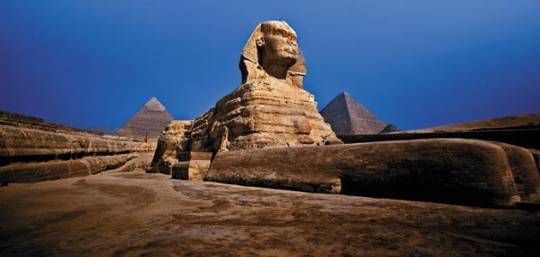
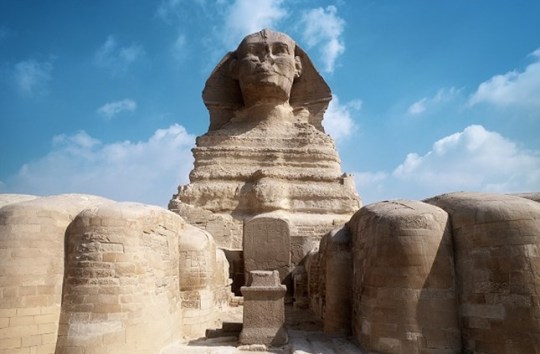
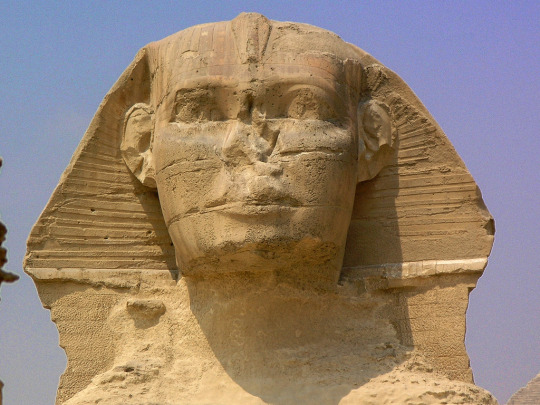
The second site I saw was the great Sphinx of Giza. The Great Sphinx of Giza came to be around the time of Pharaoh Khafre. The Great Sphinx is among the world's tallest sculptures having measurements totaling 240 feet long and 66 feet high. The Sphinx features a human head with a lion's body. There is a headdress covering the face of the sculpture with the face of the sculpture being Pharaoh Khafe's. The Sphinx was made to resemble the face of Pharaoh Khafre. It is one of Egypt's most famous landmarks. The sculpture was carved with a single piece of limestone. Historians don't know the exact purpose of the pyramid, but a lot of archeologists speculated that it was to guard the area it was in. The Great Sphinx of Giza is a monumental sculpture on its own, but historians believe that due to the proximity of other important constructions, it played a specific purpose in the layout of the area. Over time there has been a lot of damage done to the Great Sphinx of Giza due to normal wear and tear and possible vandalism. The nose on the Sphinx is no longer there and historians say either Napoleon and his crew caused the nose to fall or due to the aversion of worshipping the Sphinx, a Sufi Muslim leader destroyed the nose. There was a beard on the Great Sphinx of Giza, but it naturally eroded and fell off. Some signs lead historians to believe that the Sphinx was once multicolored. This is because there were relics of red paint found on the sculpture.
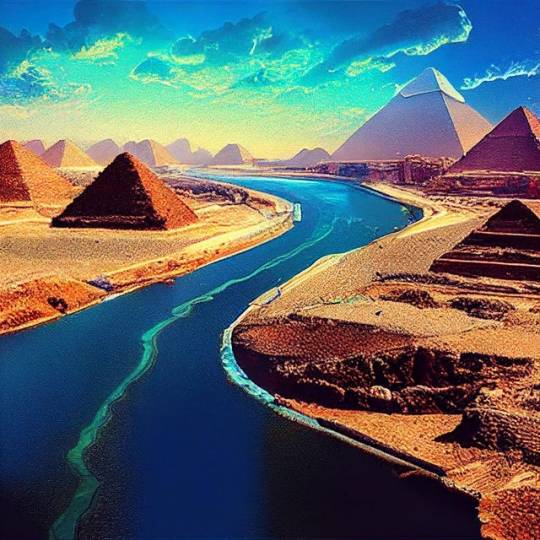
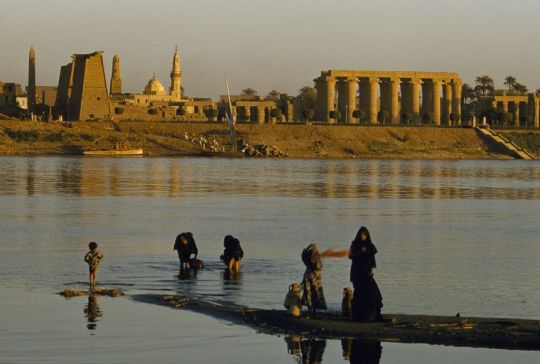

The third site I saw was the Nile River. The Nile River was essential to the rise of ancient Egypt. The Nile River flows 4,160 miles from eastern-central Africa into the Mediterranean. The Nile River provided ancient Egyptians with water to help make the soil fertile. The Nile River also helped the people of Egypt transport materials for building projects. Due to the Nile being a vital transportation route, Egyptians became skilled at building boats and ships. These ships transported important goods like wood, cattle, and vegetables. The Nile was vital to ancient Egypt because it was the main source of water in the desert, without the Nile there would have been a lack of resources regards to water. The Nile brought a unique opportunity for growth to the people of Egypt. The Nile would flood annually and depending on how much water was created silt(soil) would determine how much crops could be harvested that season. The natives had to be creative in creating tools to help create enough silt for a plentiful harvest. A form of water management practiced by the Egyptians was called basin irrigation. Basin Irrigation was a system that had the construction of water banks that created basins. Since water levels were so important to determine if the upcoming harvest would be fruitful, the Egyptians created a tool called a nilometer to measure water levels. This would help Egyptians know if they would have enough water to use for the season. The Nile also played a role in the construction of the pyramids in Egypt. The Nile was used as a means to transport the materials used in the construction of the pyramids. The Nile River also helped shaped Egyptian religious beliefs. The Nile was an important focal point in determining the Egyptian calendar because the first month of the calendar was determined by the flooding of the Nile. Egyptians even praised the deity of flooding, Hapy.


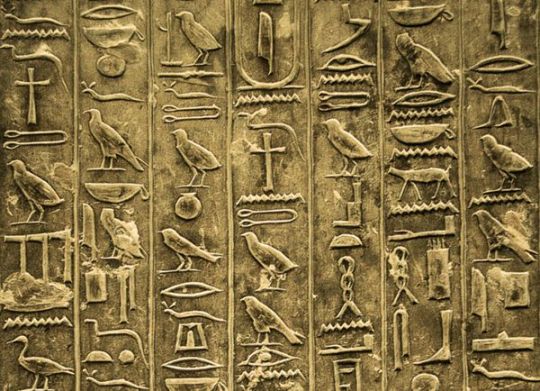
The fourth site I saw was the Hieroglyphs. Hieroglyphics is a system of writing using pictures as characters. Hieroglyphics could be read as pictures, symbols for objects, or symbols for sounds. The purpose of Hieroglyphics was to represent a royal individual or a special event with a picture on a wall. They can be found on temples walls and public monuments. Hieroglyphs were called the words of the gods by Egyptian people and were used mainly by priests. Egyptian Hieroglyphs were divided into four categories. Alphabetic signs represent a single sound, it should be noted that Egyptians didn't fully utilize vowels so some words may never be decoded. Syllabic signs are a combination of two or three consonants. Word signs are pictures of objects that are used to represent the object. Also, there are determinative signs, which are signs that help express an abstract idea. Early Hieroglyphics may have originated from the early art of Egypt. The symbols on pottery in Egypt are said to resemble hieroglyphics. Slowly through time, there have been advances in deciphering the Hieroglyphs in Egypt, but a big breakthrough came around 1799. In 1799 Napoleon's troops discovered Rosetta Stone. Rosetta Stone was a rock that had symbols carved into them. The symbols that were carved in Rosetta Stone allowed scholars to crack the code of Egyptian Hieroglyphics.
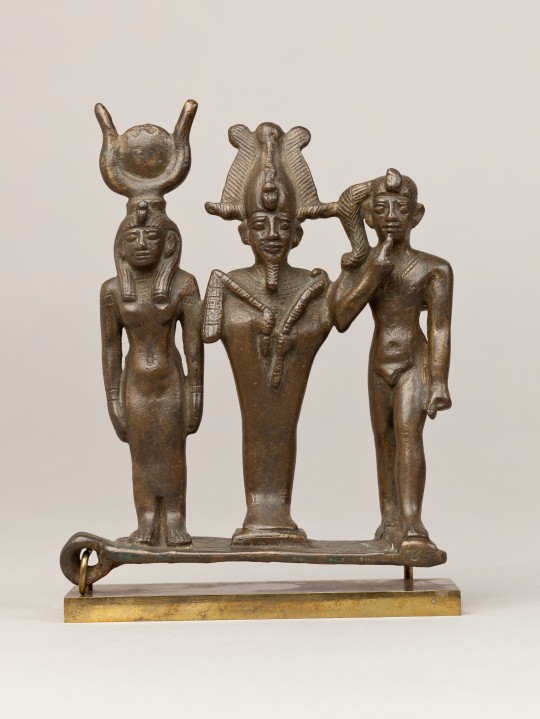

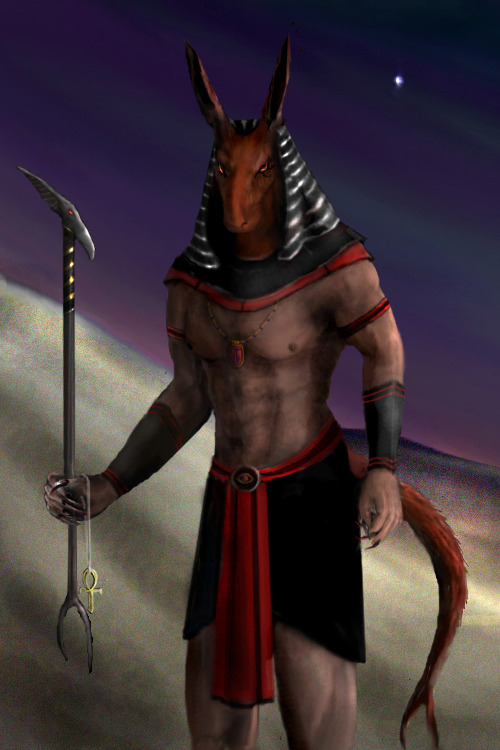
The death of Osiris is a major event in Egyptian history. According to history Set and Osiris were brothers of the divine original family of Egypt. Their father was Geb, god of earth, and Nut, goddess of the sky. They also had a sister named Isis, who plays an important role in the story. The story is told that Set is jealous of Osiris because Osiris is the king of Egypt. Osiris is known as the god of fertility and life while Set is known as the god of chaos and violence. This may have led the ancestor of Egypt to choose Osiris as king over Set. There was not a lot written about the reign of Osiris, but it was said to be a great time for Egypt. Some say that the Set vs Osiris battle was symbolism for the struggle between order and chaos. The story goes that Set tricked Osiris into a coffin where Set cut his body into a bunch of different pieces. Isis, the wife of Osiris, then looks for help to restore the dead body of Osiris. She is said to find a way to use her magic to restore all but one piece of Osiris and magically conceive a child named Horus. Horus would then Challenge his uncle Set for the throne of Egypt and later it is said he became victorious. This myth played an important role in the religion and worship of Egypt as Horus, Set, and Osiris were all worshipped by the people of Egypt at different times. Set in particular played an important role in ancient Egypt because he was the protector of Ra. It was said that Set used to protect Ra on his nightly voyage into the underworld by killing the giant serpent Apophis who represents all the evil in the world. Stories of these events and myths have been recorded in Hieroglyphics for historians to understand the History of the Egyptian people.
3 notes
·
View notes
Photo

Artwork by Claud Nyanhongo, Zimbabwean Sculptor and Father of the Shona Art Movement. [1936- 2019] Claud Nyanhongo, a renowned Zimbabwean sculptor, left an indelible mark on the world of African art. Born in Nyanga, Zimbabwe in 1934, he was part of the "first generation" of sculptors that spearheaded the Shona sculpture movement in the late 1950s, alongside other influential figures such as Joram Mariga. A Father's Legacy Nyanhongo's talent and dedication to his craft were instrumental in shaping the art scene not only in Zimbabwe but across Africa. He created a lasting legacy, passing down his love for sculpting to his children, including the internationally acclaimed artists Agnes and Gedion Nyanhongo. Together, the Nyanhongo family has helped to preserve and promote the rich artistic traditions of their homeland. Impact on the Art World Claud Nyanhongo's work has been featured in numerous exhibitions worldwide, showcasing his innovative approach to stone sculpture. His ability to transform raw materials into emotionally charged pieces has earned him admiration from collectors and critics alike. Nyanhongo's work continues to inspire contemporary artists, both within Zimbabwe and beyond its borders. A Life Well Lived Despite the challenges he faced throughout his career, Claud Nyanhongo never wavered in his commitment to art. He continued to sculpt until his passing in 2019, leaving behind a body of work that stands as a testament to his talent and passion. Today, Nyanhongo's sculptures can be found in prestigious collections around the globe, serving as a reminder of the impact one man can have on the world of art. Claud Nyanhongo was more than just a sculptor; he was a visionary who forever changed the landscape of African art. Through his work, he challenged conventional notions of sculpture and paved the way for future generations of artists to express themselves through this powerful medium. As we remember his contributions, let us celebrate the life and legacy of this remarkable artist. Follow us on Instagram, (X)Twitter, Pinterest, TikTok, Tumblr and Facebook: @blawoarts www.blawo.art #blackart #africanart #africanamericanart #blacksculpture #blawo
0 notes
Text
The Allure of Hand Painted Elephant Sculptures: A Timeless Art
Hand-painted elephant sculptures are not merely decorative items; they are a testament to the rich cultural heritage and artistic prowess of artisans from various parts of the world. These exquisite pieces blend tradition with creativity, making them coveted collectibles and remarkable centerpieces in any space. Among the myriad designs available, the Majestic Golden Elephant stands out as a symbol of grandeur and elegance, captivating the hearts of art enthusiasts and collectors alike.
The Historical Significance of Elephant Sculptures
Elephants have held a significant place in many cultures, especially in Asia and Africa, where they are revered as symbols of wisdom, strength, and nobility. In India, for instance, elephants are associated with Lord Ganesha, the deity of wisdom and prosperity. The majestic presence of elephants in ancient folklore, religious ceremonies, and royal parades underscores their importance.
Hand-painted sculptures of elephants capture these magnificent creatures in various poses, each telling a unique story. These sculptures often depict elephants adorned with intricate patterns and vibrant colors, reflecting the artistry and imagination of the craftsmen.
The Craftsmanship Behind Hand Painted Elephant Sculptures
Creating a Hand Painted Elephant Sculpture is a meticulous process that requires skill, patience, and a keen eye for detail. The process begins with selecting the right material, which could be wood, metal, ceramic, or stone. Each material lends a different texture and finish to the final product.
The sculptor first carves the elephant, paying close attention to proportions and anatomical details. This step is crucial as it lays the foundation for the painting process. Once the carving is complete, the artist meticulously paints the sculpture using fine brushes and high-quality paints. The Majestic Golden Elephant, for instance, features intricate gold detailing that highlights its regal stature.
The Artistic Appeal of Hand Painted Elephant Sculptures
The allure of hand-painted elephant sculptures lies in their ability to transform any space into a vibrant and culturally rich environment. Each piece is unique, reflecting the artist's style and the cultural influences that inspire them. The use of bright colors, intricate patterns, and elaborate designs make these sculptures visually striking.
The Majestic Golden Elephant, with its opulent gold accents and lifelike features, exemplifies the grandeur of these artworks. It is not just a decorative item but a piece of art that exudes elegance and sophistication. The golden hue symbolizes wealth and prosperity, making it a perfect addition to homes and offices aiming to create a luxurious ambiance.
Collecting Hand Painted Elephant Sculptures
For art collectors, hand-painted elephant sculptures offer a blend of aesthetic appeal and cultural significance. They are not only beautiful but also carry stories of the artisans who created them. Each sculpture is a piece of history, reflecting the traditions and skills passed down through generations.
The Majestic Golden Elephant, in particular, is a prized possession for collectors. Its intricate design and majestic appearance make it a standout piece in any collection. Whether displayed on a mantle, in a display cabinet, or as a centerpiece, it commands attention and admiration.
Conclusion
Hand-painted elephant sculptures are more than just decorative items; they are embodiments of cultural heritage and artistic excellence. The process of creating these sculptures is a labor of love, requiring immense skill and dedication. The Majestic Golden Elephant stands as a testament to this artistry, capturing the majestic essence of these magnificent creatures.
Incorporating a hand-painted elephant sculpture into your decor not only enhances the aesthetic appeal of your space but also brings a piece of history and culture into your home. Whether you are an art enthusiast, a collector, or someone looking to add a touch of elegance to your space, these sculptures offer a unique and timeless appeal. The Majestic Golden Elephant, with its exquisite detailing and regal presence, is a perfect representation of this timeless art form.
0 notes
Photo




(via Tokara's Rare Plant Fair & Open Garden 2024 )
Tokara's Rare Plant Fair & Open Garden 2024 Tokara invites the public to enjoy a day of botanical splendour at the Rare Plant Fair and Open Garden on Saturday, 26 October 2024. This special event usually occurs in autumn but was postponed due to the devastating Cape storms.
This year, it will be part of the Stellenbosch Garden Town festival, one of South Africa's most celebrated garden lifestyle events, which runs from Friday, 25 October to Sunday, 3 November 2024.
Experience Tokara in all its glory as this renowned Stellenbosch family wine and olive estate opens its private farm garden to the public. The annual Rare Plant Fair features exhibitors from far and wide, presenting a unique opportunity for gardening enthusiasts to acquire rare and exotic plants.
Cultivate your own spring retreat from a diverse selection of indigenous and exotic flora available for purchase on the day. Stroll through tranquil garden paths adorned with magnificent sculptures by local artists. Highlights include terraces of the picking garden, serene wetlands, a textural cork oak forest, and a babbling mountain stream flowing into soothing lily ponds.
Discover the dedicated oasis of indigenous flora and the extraordinary Adamastor Moss Garden, a continually evolving masterpiece. The past two years have seen the remarkable integration of local sandstone, granite, indigenous mosses, and fynbos in the Moss Garden.
This year, the garden's beauty is further enhanced by hand-chiselled Paarl granite pieces, creating a kaleidoscope of muted hues and textures. The newly completed hewn stone lintels framing the garden invite visitors to experience the tranquil beauty reminiscent of a Japanese-inspired South African landscape.
Moss garden expert Gert van Tonder and his team will conduct guided tours daily. Besides delicious nourishments and refreshments in the farmyard, Tokara will be well represented with its elegant wines and award-winning extra virgin olive oils.
This year, you can pre-order a picnic box filled with local delicacies from the Tokara Delicatessen. The Rare Fare Picnic Box for two is available at R495 for adults and R150 for children and can be ordered via email at [email protected] before 23 October 2024.
Collect your picnic at the Boathouse next to the unique Dionysus sculpture and enjoy a leisurely meal on the rolling lawns below the main house. Event Details The Tokara Rare Plant Fair and Open Garden 2024 is open from 08h00 to 16h00. Entry is R100 per vehicle, payable at the gate on the day. The Tokara Tasting Lounge, Restaurant, and Delicatessen will be open as usual on Saturday. For more information, visit www.rareplantfair.co.za or email [email protected].
Diary Listing Information:
Date: Saturday, 26 October 2024 Time: 08h00 – 16h00 Tickets: R100 per vehicle, payable on the day at the farm gate. No pre-booked tickets are available. Proceeds will go to the Camphill Farm Community in Hermanus, a dynamic community for adults with intellectual disabilities.
Food and Other Refreshments will be available at stalls in the Farmyard.
Pre-paid Picnics: Rare Fare Picnic Boxes at R495 for two adults and R150 for children, book via [email protected] before Monday 21 October 2024, collect at the Boathouse and enjoy on the big lawn.
Venue: Tokara Wine Estate, Helshoogte Pass, Stellenbosch
Contact: [email protected], www.rareplantfair.co.za Join us at Tokara for an unforgettable celebration of Spring and botanical treasures amidst the captivating landscape of the Simonsberg Mountains.
About Tokara Wine Estate Tokara Wine Estate is situated on the slopes of the Simonsberg mountain in Stellenbosch, South Africa. Founded on the forward-thinking vision of owners GT and Anne-Marie Ferreira, Tokara's unwavering commitment to producing world-class wines without compromise and with a distinct South African identity has positioned it as a beacon of excellence in the winemaking industry.
With a special focus on Cabernet Sauvignon, Tokara consistently delivers exceptional wines that reflect the unique terroir of Stellenbosch. In addition to their acclaimed wines, Tokara also produces award-winning olive oil, showcasing their dedication to quality and innovation in every product. For more information about Tokara, visit www.tokara.com.
0 notes
Text
Benefits associated with amber gemstones

Amber Gemstone
Amber is a fossilized tree resin that is often used as a gemstone in jewelry making. It has a warm, golden color and is prized for its beauty and rarity. Amber is formed over millions of years as the resin from ancient trees hardens and becomes trapped in sediment, where it undergoes a process of fossilization.
Amber is found in many parts of the world, including the Baltic region of Europe, where it has been mined for centuries. It can also be found in other parts of Europe, as well as in Asia, North and South America, and Africa.
In addition to its use in jewelry, amber has been used for a variety of purposes throughout history. It has been used as a natural remedy for various ailments, such as respiratory and digestive problems, and has been used in traditional medicines for centuries. Amber has also been used in art and sculpture, and has been a popular material for beads, carvings, and other decorative objects.
Benefits with amber gemstones
1-Promotes emotional healing: Amber is known to promote emotional healing by helping to alleviate stress, anxiety, and depression. It is believed to help balance emotions and increase positive energy.
2-Enhances physical health: Amber is thought to have analgesic and anti-inflammatory properties, making it a popular choice for natural pain relief. It is also said to aid in digestion and boost the immune system.
3-Soothes teething pain: Amber teething necklaces are a popular choice for parents who want a natural remedy for their teething babies. The warmth of the amber is thought to help soothe pain and reduce inflammation in the gums.
4-Enhances spiritual awareness: Amber is said to promote spiritual awareness and help with meditation. It is believed to help balance the chakras and increase positive energy flow.
5-Protects against negative energy: Amber is thought to have protective properties, shielding the wearer from negative energy and promoting a sense of calm and inner peace.
It is important to note that while many people believe in the benefits of amber, these claims have not been scientifically proven. As with any alternative therapy, it is always best to consult with a healthcare professional before use.
What is the amber stone good for?
Is amber a expensive gem?
What does amber gemstone do?
Buy Natural Amber Gemstone Online at Best Prices
Buy Amber Stones Online at Best Price
Buy Amber Gemstone Online at Best Price delhi
Buy Amber Stone Online at Best Price in India
Amber gemstone price
Amber gemstone benefits
Amber gemstone meaning
Amber Gemstone Ring
Amber Gemstone hypixel
Amber gemstone price in india
Unit of Salasar Ji Gems LLP 1185-87, Shop No. 9, Gems Plaza, Chhatta Madan Gopal, Maliwara, Chandni Chowk, Delhi, India, 110006
9971391757
0 notes
Text
The British Museum: A Journey Through Humanity’s Treasures
The British Museum, located in the heart of London, is one of the world's most prestigious and comprehensive museums. It offers an unparalleled glimpse into the rich tapestry of human history, spanning over two million years. The British Museum in London stands With a collection that exceeds eight million objects, the museum showcases treasures from every corner of the globe, providing invaluable insights into how people lived, what they created, and the civilizations they built. There are many other amazing places in London to visit for adventure and fun in addition to this museum!
A Global Collection

The British Museum's collection is remarkable not only for its breadth but also for its diversity. Artifacts from every inhabited continent are represented, offering a global perspective on human history. The museum is organized into various departments, each dedicated to a specific geographical region or theme, such as Ancient Egypt, Greece and Rome, the Middle East, Asia, Africa, the Americas, and Europe.
One of the most famous artifacts is the Rosetta Stone, which was crucial in deciphering Egyptian hieroglyphs. This stone, inscribed with the same text in three scripts (Greek, Demotic, and hieroglyphic), unlocked the secrets of ancient Egypt, allowing historians to understand its language and culture. The Rosetta Stone is not just a piece of rock; it is a key to understanding a civilization that flourished over 5,000 years ago.
Ancient Egypt: A Window into the Past
The Egyptian collection is one of the largest and most comprehensive in the world, featuring mummies, statues, jewelry, and everyday objects from ancient times. Highlights include the colossal bust of Ramesses II and the exquisitely decorated sarcophagus of Cleopatra. These artifacts provide a window into the religious beliefs, social structures, and daily lives of the ancient Egyptians.
The museum's extensive collection of mummies and funerary items offers a fascinating look at ancient Egyptian burial practices and beliefs about the afterlife. The intricately decorated coffins and the well-preserved bodies of mummies, such as the famous "Ginger," a naturally mummified body from Egypt’s Pre-dynastic period, give us insights into the rituals and artistry of this ancient civilization.
The Glory of Greece and Rome

The Greek and Roman galleries are equally impressive, with iconic pieces such as the Parthenon sculptures and the Portland Vase. The Parthenon sculptures, also known as the Elgin Marbles, are a collection of classical Greek marble sculptures that once adorned the Parthenon temple in Athens. These sculptures are masterpieces of classical art, depicting gods, heroes, and mythological scenes with extraordinary skill and detail.
The Portland Vase, a Roman cameo glass vessel from the 1st century AD, is another highlight. It is considered one of the finest examples of Roman glasswork, showcasing the artistic and technical prowess of ancient Roman artisans. The vase’s intricate scenes and delicate craftsmanship continue to captivate visitors and scholars alike.
The Riches of Asia
The museum's Asian collection is vast, with artifacts from China, Japan, India, and Southeast Asia. The Chinese collection includes exquisite ceramics, jade carvings, and ancient bronzes, highlighting the advanced craftsmanship and cultural achievements of Chinese civilization. The Japanese galleries feature samurai armor, ukiyo-e prints, and tea ceremony utensils, reflecting Japan's rich cultural heritage and artistic traditions.
Indian art and sculpture are also well-represented, with significant pieces such as the Sultanganj Buddha, a massive bronze statue from the 5th century AD. This statue is a testament to the sophistication of ancient Indian metallurgy and the spiritual significance of Buddhism in the region.
Middle Eastern Marvels

The Middle Eastern collection includes artifacts from ancient Mesopotamia, Persia, and the Islamic world. The museum boasts one of the largest collections of Mesopotamian artifacts outside Iraq, including the iconic Assyrian lion hunt reliefs and the epic of Gilgamesh tablets. These artifacts shed light on the early development of writing, law, and urbanization.
Persian artifacts, such as the Oxus Treasure, a collection of gold and silver objects from the Achaemenid Empire, illustrate the opulence and artistry of ancient Persia. The Islamic art collection features exquisite calligraphy, ceramics, and textiles, reflecting the rich cultural and artistic traditions of the Islamic world.
The Americas and Africa
The museum's collection from the Americas includes artifacts from pre-Columbian civilizations such as the Aztecs, Maya, and Inca. Highlights include the turquoise serpent mask of the Aztec god Quetzalcoatl and the intricately woven textiles of the Inca. These objects provide a glimpse into the religious beliefs, social structures, and artistic achievements of ancient American civilizations.
The African galleries feature an array of objects, from the Benin Bronzes to Ethiopian manuscripts. The Benin Bronzes, a group of plaques and sculptures from the Kingdom of Benin, are renowned for their intricate detail and historical significance. These artifacts tell the story of a sophisticated African kingdom with a rich cultural and artistic heritage.
Conclusion: A Treasure Trove of Knowledge

The British Museum is more than just a repository of artifacts; it is a treasure trove of knowledge and a testament to human ingenuity and creativity. Each object in the museum’s collection has a story to tell, offering insights into the lives of people from different times and places. By exploring these treasures, visitors can embark on a journey through history, discovering the common threads that connect us all and the unique cultures that enrich our world.
0 notes
Text

Roman statue of Venus
During the 2nd century AD the most coveted stone for Roman emperors was bigio morato, a dark grey almost black marble sourced from Africa; the most notable example of this marble used in sculpture is the Furietti centaur statues discovered at Hadrian’s imperial palace at Tivoli.
from here
8 notes
·
View notes
Text
ART IN AFRICA BY CATHERINE N WHITTLE DD

ART IN AFRICA
by Catherine N Whittle DD
COLLECTION OF ARTWORKS
IN EXPLORATION OF THE LINK
BETWEEN ART AND FAITH
Art in Africa draws from the richly diverse palette of nature. Everywhere you look, there is teeming life. People bustle in cities, towns, market-places and villages. Buses chug along the roads, avoiding ever-proliferating potholes, Busy matrons shop for fresh fruit and vegetables. Children dance on their way to school.
Earnest employers worry about finance and doodle amazing creations upon their notepads as they wistfully look out at clear summer days through boardroom windows. Many draw, knit or needlepoint. Photographers create unforgettable moments in time. Artisans sign their work with flair. Architects add touches to works of stone. Fish swim in waters, birds fly, animals roam. Painting, exquisite borders, colourful materials, creatively cut clothing, decorated churches and beaded sculptures enrich society.
The heart of Africa draws inspiration from the Great Creator. Everyone is an artist. Little oxen are fashioned by nimble fingers from clay after rain. Mothers decorate baking with icing art and syrup drawings. Fathers paint hilarious messages on motor cars.
Tin cans are punched with decorative patterns. Gardens boast metal windmills, butterflies, cats, dogs and meercats. Forgotten sculptures beautify abandoned fields. Children race in handmade go-karts. Energetic youngsters push wire cars with rattling wheels. Wooden crucifixes with silken flowers form wayside shrines. Church members make banners, flower displays and lace-and-linen cloths.
Prayer breathes forth from diverse artistic talents. Artists in Africa share unique vision of creative blessing. Each one of us is an artist as children of Creator God. May you be inspired to find your own artist within.
Download your free Art in Africa book. Feel free to use images copyright free for any worthy purpose.
To access the book, please click in the link below:
https://drive.google.com/file/d/1gBIECZWD4-hP_eE6TVTzADQdjDo0sGvn/view?usp=drive_link
0 notes
Text
Gravestone Prices and Cultural Considerations: A Global Perspective
In the vast tapestry of human cultures, the ways in which we memorialize our departed loved ones vary significantly. Gravestones, serving as enduring symbols of remembrance, are deeply intertwined with cultural practices and traditions. This blog takes a journey around the world to explore the intricate relationship between gravestone prices and cultural considerations, shedding light on the diverse practices that shape memorialization on a global scale.
1. Asia: Tradition Meets Modernity
In many Asian cultures, the act of honoring ancestors is a sacred and time-honored tradition. Gravestones in these regions are often crafted with meticulous attention to detail, featuring intricate designs and symbolic elements. The materials used, ranging from traditional stones to more modern options, reflect the evolving nature of these practices. For example, in China, where filial piety holds great importance, gravestones may be adorned with family crests and intricate carvings representing virtues and familial connections. Japan, on the other hand, embraces simplicity in gravestone design, often featuring minimalist yet poignant symbols.
As these cultures undergo modernization, there is a fascinating interplay between tradition and contemporary influences on gravestone choices. Urbanization and changing lifestyles impact the materials used and the overall design aesthetics, reflecting a delicate balance between honoring cultural heritage and embracing the present.
2. Europe: Timeless Elegance and Historical Significance
In Europe, gravestones often serve as not just markers but as historical artifacts that reflect the rich cultural heritage of the continent. Ancient cemeteries boast elaborate stone sculptures and monuments, showcasing the craftsmanship of bygone eras. Modern European gravestones, while embracing a more minimalist approach, often exude an air of timeless elegance.
Countries like Italy, France, and the UK have distinct traditions influencing gravestone choices. Religious affiliations play a significant role, with Catholic-majority countries often featuring symbols and designs associated with the faith. The Gothic architecture of some European gravestones pays homage to historical periods, creating a sense of continuity and connection to the past.
3. Africa: Vibrancy and Symbolism
In various African cultures, the act of remembering the departed is characterized by vibrancy and symbolism. Gravestones are not merely markers; they are expressive symbols of cultural identity. Colors, shapes, and unique materials play a crucial role in gravestone design across different regions. In parts of West Africa, for instance, brightly colored gravestones adorned with symbolic carvings celebrate the life of the deceased, reflecting a communal approach to mourning.
Additionally, communal burial grounds hold significant cultural importance, fostering a sense of togetherness and community even in times of grief. Understanding the cultural context is key to appreciating the significance of these vibrant and expressive gravestones.
4. North America: Individuality and Personal Expression
In North America, particularly in the United States, gravestone practices often reflect the cultural diversity and emphasis on individuality. Gravestones become a canvas for personal expression, influenced by factors such as religious beliefs, ethnic backgrounds, and regional customs. The United States, being a melting pot of cultures, sees a wide range of gravestone styles, from classic marble monuments to contemporary designs featuring personalized engravings and even photographs.
Religious affiliations also play a significant role in shaping gravestone choices, with symbols and inscriptions reflecting the beliefs of the departed and their families. The evolving trend toward individuality underscores the importance of expressing one's identity even in the solemnity of memorialization.
5. South America: Blending Tradition with Modern Trends
In South America, countries like Mexico and Brazil showcase a unique blend of tradition and modernity in gravestone practices. In Mexico, the vibrant celebration of Dia de los Muertos influences gravestone designs, with colorful decorations and offerings. This cultural celebration extends to the gravestones themselves, creating a lively and celebratory atmosphere in cemeteries.
In Brazil, economic factors also come into play, influencing gravestone prices. While some families may opt for elaborate and ornate designs, others may choose more modest options, highlighting the economic diversity within the country.
If you are looking for slant headstones for graves, you can visit the site of Michigan Headstones today. Explore our gallery to witness the diverse array of granite options available, each offering a unique aesthetic appeal. Customization options extend beyond the material itself – choose between etched lettering or raised lettering to add a distinctive touch to the memorial. Understanding that each individual is unique, our grave markers are designed to reflect and celebrate the special qualities that made loved ones extraordinary.
In the spirit of commemorating a life well-lived, grave markers are crafted with care and attention to detail. Whether preferring a classic and understated design or a more elaborate and adorned marker, a range of options is provided to ensure that the memorial is a fitting tribute to the memory of loved ones.
Conclusion:
As we traverse the globe, it becomes evident that gravestone prices are not merely determined by the materials used and the intricacy of design but are deeply rooted in cultural considerations. The act of memorialization is a nuanced reflection of a society's values, traditions, and evolving trends. Gravestones, far from being mere markers, are tangible expressions of the rich tapestry of global cultures. Understanding the global perspectives on gravestone choices provides profound insights into the diverse ways in which people honor and remember their loved ones, showcasing the delicate dance between tradition and modernity in the realm of memorialization.
0 notes
Text
12 Best Things To Do In Kozhikode, India
If you are a seaside lover, then you will not be able to face up to coming to the easy and untouched seashores of Kozhikode, Kerala, India. It became traditionally a potent seaport in the international where buyers from Arabia, China, and Africa as soon as converged. The maximum well-known explorer in the global, Vasco da Gama landed at the seashores of Kozhikode in 1498 and put it for all time inside the history books. It has the whole lot a traveler center must have, from a great geographical region to pristine clear beaches, ancient websites, herbal wildlife sanctuaries, well-known rivers, and hills. Consider staying at the top Airbnb excursion rentals in town, and read on to discover about the high-quality activities in Kozhikode, India. From Maximum City to Maximum Serenity Kerala tours from Mumbai Await.

1. Check out Pazhassiraja Archaeological Museum
If you’re into archaeology, pay a go to to Pazhassiraja Archaeological Museum on East Hill. This museum and artwork gallery capabilities an extensive series of artifacts from a thousand BC to 2 hundred AD. These shows include gadgets from the Indus Valley Civilization and the megalithic age which encompass toys, stone, and metal sculptures. Aside from those, warfare guns of British infantrymen are displayed at the gallery too. The museum building become constructed in 1812 as East Hill Bungalow and turned into subsequently changed into a museum in 1976.
2. Visit the medieval Mishkal Mosque
This medieval mosque is one of a type within the nation and is taken into consideration a huge monument. It become built within the 14th century by way of a merchant and shipowner. The constructing in the beginning had five ranges however, for the duration of a Portuguese attack in 1510, the mosque changed into partly burned. After its upkeep within the past due 1570s, most effective four tales have been restored and the top-level still suggests the harm.
3. Learn business history at Indian Business Museum, IIM Kozhikode
If you’re on a museum-hopping journey in Kozhikode, don't forget adding Indian Business Museum for your itinerary. Established in 2013, the museum keeps a unique focus on the records of Indian commercial enterprise by means of amassing and retaining the industry’s wealthy history. Indian Business Museum additionally intends to spark interest in entrepreneurship amongst residents. The museum is taken into consideration the first of its kind inside the us of a. Come and take a ride to the museum, and who knows, a visit right here may additionally just be the begin of your business-savvy!
4. Explore the backwaters of Kozhikode
Kozhikode is well-known for its virgin waters. The backwaters provide traffic a chance to explore the natural beauty of Kerala at its top. It has palm timber dotted all along the water banks and the canal and lakes offer the guests best houseboat cruising. You can take within the natural beauty of the backwaters when sailing on a houseboat. The non violent surroundings and tranquility all round will soothe your spirits. You can also live at the luxurious floating villas all over the beautiful backwaters of Kozhikode. These houseboats at the backwaters are famous, particularly among honeymooners as they offer a really perfect getaway within the picturesque environment and herbal splendor.
5. Kozhikode beach
Kozhikode, the maximum important place of Malabar in yesteryears, changed into the capital of the powerful Zamorins and also a outstanding exchange and commerce center. It became right here at Kappad that Vasco Da Gama landed in his look for the spices of the Orient. Today, the serene seashores, lush inexperienced geographical region and historical web sites all combine to make this a famous traveler vacation spot packed with a heat environment.
Kozhikode Beach is a fave hang-out of sundown visitors and it is also an awesome location for attempting out seafood delicacies like kallumekaya (mussels), available at the numerous stalls lining the promenade. At sunrise, a stroll alongside Dolphin’s Point will reward you with a sight of playful dolphins. Adding to its herbal beauty is the antique world charm retained with the aid of the antique lighthouse and the two crumbling piers that run into the ocean, every extra than a hundred years vintage. Entertainment facilities including the Lions Park for youngsters and the marine water aquarium are introduced attractions.
6. The historic Thikkodi lighthouse
One of the satisfactory matters to peer in Kozhikode is Thikkodi Lighthouse that's placed in Thikkodi village. It is a historic monument which attracts travelers and visitors around the year. There are rocks across the lighthouse and it gives you a wonderful view of Velliyamkallu that is a rock formation in the Arabian Sea. The Thikkodi lighthouse became constructed in 1847 and is a big shape. Tourists can climb up the steps of the lighthouse to attain the top of it and revel in the excellent view of the surrounding region, but previous permission is required by travelers from government to climb up the lighthouse winding stairs.
7. Visit the quiet Kappad seashore
Kappad seashore, or Kappadavu as it is acknowledged domestically, is a quiet coast shaded via inland palm groves around a small, non violent village not but located with the aid of ‘mainstream’ tourism. There are resorts close to the seaside, we had been informed by means of a group of boys on arrival, the costly one and the opposite one. We stayed at the other one and enjoyed a number of our quality days on Kerala’s stunning coast. The beach of Kappad has a rocky headland which offers excellent perspectives of the surrounding coast. Walking along the beach either manner ends in miles of deserted, yellow-sand beaches with only the bizarre fishing boat or egret for business enterprise.
8. Trip to the historical and but modern-day 'Big marketplace' Veliyangadi
Veliyangadi or the massive marketplace is positioned on the south facet of the Kozhikode seaside. It become here a few centuries in the past where European and Arab buyers used to sweep shoulders buying and selling their items. Here, you may discover neighborhood items at very reasonable expenses, that's why people here come to store all their necessities. Once right here, you'll get a taste of neighborhood meals and items and additionally see how the locals do their buying here.
At Veliyangadi there may be a Gujarati road and also a Halwa road. You will also find the Francis Road and the Thangal Road right here which, along side the Halwa Street, form a triangle which results in Bavutty Haji Road at the seashore. There is a Sunni dargah called the ‘Sheikh Makham,’ which is a center of Sunni pilgrimage to Kozhikode. Kerala trip package from Mumbai Where Coastal Bliss Meets Cultural Delights.
9. Visit the ancient pond at Mananchira
Mananchira is a person-made water pond in the middle of Kozhikode in Kerala nation in India. The pond is rectangular in shape. It changed into constructed as a washing pool inside the 14th century. However, within the nineteenth century, its municipal council ruled it for use completely for consuming functions only and prohibited it from the usage of bathing or washing. Visitors coming to Kozhikode frequently come here to look this centuries-old pond as a historical vicinity.
10. Regional Science Center and Planetarium
The Regional Science Center and Planetarium is positioned on Museum Road in Kozhikode. It has a 250 seater Planetarium which offers traffic an extensive insight into the mysterious universe, planets and all the galaxies. This Kozhikode enchantment has a country of the art Zeiss projector which simulates the night sky and is interesting and really informative.
The Regional Science Center has indoor in addition to out of doors technological know-how shows. One of the main things to look here is the entomology segment known as the Giants of Nature. The big aquarium is likewise a popular appeal here. Visitors timing is 10:30 a.M. To six:30 p.M.
11. A Nature Trip to Kadalundi Bird Sanctuary
One of the maximum excellent visitor attractions in Kozhikode is the Kadalundi Bird Sanctuary. It draws pretty a number of nature and photography fanatics because of its picturesque place at the same time as providing a extremely good view of both the Arabian Sea and the Kadalundipuzha River. Bird watchers can take their time to stroll around the vicinity via the boardwalk, get to recognise the unique avian fauna, and take awesome pictures along the manner. With over a span of 3 kilometers, travelers have the option of taking boat rides to revel in the scenery. Aside from the colorful migratory birds that serve as the primary attraction, guests can also glimpse of deep water crocodiles. The first-class time to go to would be around the months of October to April when you consider that it's miles in the course of these months that migratory birds flock inside the place. Bring your digicam and capture all of the surprising shots in this sanctuary!
12. Visit the tranquil SreeKanteswara Temple
Among the numerous temples in Kozhikode, every other one that you may upload to your list is a visit to Sreekanteswara Temple. Unlike different bigger temples, this one has a tranquil ambience that both site visitors and worshippers can see upon arriving. A Shiva temple that is rich in history, it's far said that from a long time ago, this vicinity has emerge as wealthy and nicely-cherished because there has been as soon as a noteworthy yogi who worshipped there, and numerous divine rituals finished in the area in which it stands now. Now doesn’t that sound exciting? After worship, take a stroll round, study the history of the temple, or even take a few images. Both locals and vacationers are welcome to go into so make sure to feature this in your list of locations to visit in Kozhikode!
A melting pot of subculture and records!
Kozhikode in Kerala offers visitors a danger to mixture into its historical and cultural past. From the high-quality spots for biryani to the excellent tourist points of interest, Kozhikode is a treasure chest waiting to be found. Its quiet seashores and backwaters provide calmness and quietness to the ones from busy metropolis lives seeking out a soothing holiday.
Suggested Read:
6 Best Huts In Kerala, India - Updated 2023
Eco Hotels In Kerala, India - Updated 2023
0 notes
Text




















Save The Elephant Day
Volunteer or donate to Save an Elephant, and help preserve these majestic, intelligent, and of course giant threatened creatures that shape our ecosystems.
Elephants are known as the most enormous land animal and a surprisingly gentle giant in the animal kingdom. Emotional, intelligent and beautiful in the wild, sadly elephant populations have been rapidly decreasing due to various threats, perhaps most significantly poaching.
Save The Elephant Day aims to change this alarming trend by educating people about elephants and the plights they face, encouraging everyone to do their bit and help save them from extinction.
A brief education in elephants
There are currently three species of elephant spread across Africa and Asia: the African bush elephant, the African forest elephant and the Asian elephant. Characterized by their enormous size and highly adept trunks, these creatures are intelligent, social and largely gentle giants. They’ve been shown to display a range of emotions such as joy, anger and grief and live in complex social structures – matriarchal herds for the female cows and calves and a solitary lifestyle or bachelor herds for the male bulls.
Elephants are highly communicative animals, producing various noises including infrasonic, creating seismic vibrations over long distances and greeting each other through touch. Their impressive trunks provide them with an excellent sense of smell, a handy snorkel when swimming and even a delicate nutcracker.
History of Save The Elephant Day
Elephants are what is known as a keystone species due to their effect on their environment and the flora and fauna around them. Their size and strength allow them to shape the habitats they live in, for example by digging new watering holes. They are also vital for spreading seeds, facilitating the reproduction of various plant and tree species.
They have also long been valued in human culture, admired for their wisdom, strength and sociable natures. They have commonly featured in architecture, whether engravings on cave walls, sculptures in Buddhist temples or stone carvings on Gothic churches. They have also been revered in various world religions, believed to house the souls of ancestors and linked with thunder and lightning, for example. Perhaps the best-known example is the Hindu god Ganesha, who is depicted as having the head of an elephant.
Elephants are frequently used as working animals in Asia, with people drawing on their incredible strength to carry heavy loads in construction projects or provide a mode of transport. In ancient times they were even used in various wars.
Yet despite our affinity with and indebtedness to these amazing animals, our treatment of them has sadly led to a decline in numbers and a proliferation of abused and exploited elephants. The main culprit in population decline is the ivory trade – although it has largely been banned since the late 1980s, illegal poaching continues to this day, with one African elephant killed every 30 minutes for its tusks.
Other threats to the elephant include habitat loss and fragmentation, usually caused by increased urbanization, and conflicts with humans over crops. There are also numerous instances of maltreated and neglected elephants in captivity, for example those used in circuses or as tourist attractions.
Sadly, African bush elephants and Asian elephants are both listed as an endangered species by the International Union for Conservation of Nature (IUCN), while African forest elephants are classed as critically endangered, with their population rapidly declining.
While these facts are certainly sobering, all hope is not lost! Various organizations are working hard to increase the number of wild elephants and to rehabilitate those rescued from unpleasant circumstances. And real change is possible – lobbying efforts recently induced China, previously the biggest ivory market globally, to ban the trade in 2018, helping reduce the threat to elephants.
To celebrate Save The Elephant Day, people learn about the awesome elephant and make an effort to improve the worrying statistics regarding their numbers by donating to conservation organizations. Together we can work to protect these precious creatures, and that’s what Save The Elephant Day is all about!
How to celebrate Save The Elephant Day
One of the best ways to celebrate Save The Elephant Day is to support or even volunteer for an organization that focuses its efforts on the conservation of these creatures, for example by helping to prevent poachers from killing elephants for their ivory tusks. Organizations such as the World Wide Fund for Nature (WWF), Fauna & Flora International (FFI) and the Elephant Crisis Fund (ECF) do a great job protecting these creatures and there are plenty of ways you can get involved, for example by adopting an elephant for yourself or a loved one.
You can even save up some money and take a trip to an animal sanctuary that cares for elephants. These projects can help with the rehabilitation of abused animals that have been rescued from exploitation, as well as with the housing of wild elephants that are sick or orphaned. You could also go and see some elephants in the wild by visiting Africa or Asia.
Save The Elephant Day is all about raising awareness, so take the time to learn more about these creatures by researching facts about the elephant, and then take an active effort in educating other people. For example, you could post flyers, share information on social media and show your support for the elephant through events and fundraisers.
There are plenty of ways you could help raise funds for elephant conservation. How about a themed bake sale or a ‘pin the tail on the elephant’ contest? Why not try auctioning off some elephant artwork or other memorabilia? Or you could organize an ‘elephant walk’ and compete to see who can plod their way the farthest!Whatever you do to celebrate, be sure to share this important day with your friends, family neighbors and colleagues and help save the elephants together!
Source
#Kaeng Krachan Elefantenpark#Zoo Zürich#Kaeng Krachan elephant park#daytrip#original photography#Asian Elephant#Elephas maximus#Zurich#Schweiz#Switzerland#indoors#animal#Save the Elephant Day#SaveTheElephantDay#16 April#tourist attraction#landmark#spring 2017#2018#flora#eating#fauna#architecture
0 notes